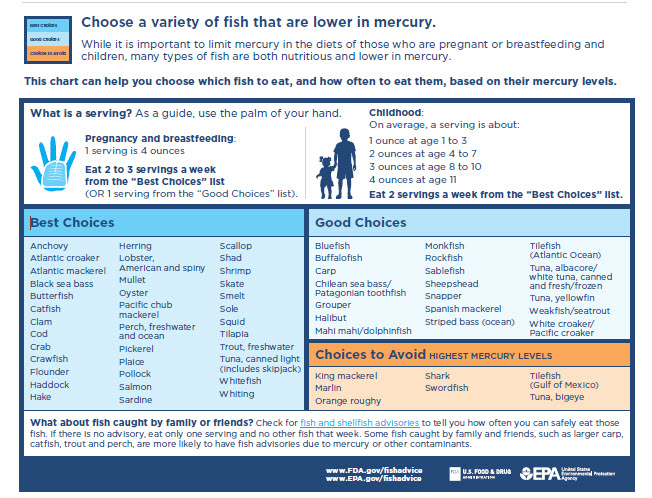Springtime means smelt! But how do we know it’s safe to eat?
Changes in environmental practices, regulations, and control of pollution over the past 50 years have reduced concerns about eating fish.

Americans do not eat enough fish according to the recommendations in the Dietary Guidelines for Americans. Fish are a good source of natural vitamins such as vitamin D (improves sleep) and omega-3s (heart healthy as it lowers the risk of strokes, heart attacks, and hypertension), and considered a brain booster (helping treat or prevent depression or ADHD and improve cognitive development). Often, concerns about contaminants keep people from choosing fish, but remember, just like all other foods in the food pyramid, eating fish improves health and provides essential minerals we need. Changes in environmental practices, regulations, and control of pollution over the past 50 years have improved not only our water supply but also our local fisheries supply, which reduces concerns about eating fish.

https://www.fda.gov/media/102331/download?attachment.
Change begins in the 1970s
Contaminant monitoring programs in the Great Lakes waters started in the 1970s. Under the Clean Water Act and the Great Lakes Water Quality Agreement, regulating agencies across the Great Lakes began new environmental protective, monitoring, and reactive measures - all to decrease contaminants that were known or suspected to cause health impacts to people. Because our lives, and the lives of our food sources and environment, greatly depend on this water, many programs led to policy changes and more regulations. The U.S. now has many programs to protect not only water but also the potential environmental chemical hazards that can enter food supply chains - including fish.
What are the contaminants?
Environmental chemical contaminants such as heavy metals, pesticides, and industrial chemicals that can be found in both farm-raised and wild-caught fish can pose a potential food safety hazard. Sources of the contaminants are wide-ranging and can be introduced through human activities or naturally present in the environment. Compounds that accumulate in fish typically are persistent and do not easily break down in the environment, can be carried long distances by air or water, and vary greatly in different types of fish species based on their eating habits, ecology, and nature of the fish such as its age.
Chemical contaminants that may be present in the Great Lakes include: Chlordane, DDTs, Diquat, Dioxin’s, Methylmercury, Mirex, Penoxsulam, PCBs, among others. The most common restrictions in Great Lakes fish typically include PCBs, mercury, and dioxins as they drive the majority of fish consumption advisories in both U.S. and Canada. Many people are now interested in testing for and learning about perfluorooctane sulfonate (PFOS) and polyfluoroalkyl substances (PFAS), lab-created chemicals that have been in commercial use since the 1940s.
Contaminant trends in Great Lakes Fish
Following the use of regulations and remediation efforts over several decades much of these contaminants have sharply declined and began to plateau by the mid-1990s. This decline shows a reduction in the addition of these chemicals entering the environment. Many agencies work to ensure adequate, routine testing of fish is done to determine guidelines per regulations, including the Environmental Protection Agency (EPA), U.S. Department of Agriculture, Michigan’s Department of Environment, Great Lakes and Energy (EGLE), Chippewa Ottawa Resource Authority (CORA), Great Lakes Indian Fish & Wildlife Commission (GLIFWC), and others.
Overall, fish consumption contaminants in edible portions of fish have declined over time in Lake Superior. In lakes Erie and Huron, the status has been unchanged since 2015 – meaning there is little to no introduction of new contaminants into the system. Of what does change, some new mercury has been traced to coming from the local watershed (or landscapes) rather than from industrial or atmospheric pollution.
Putting smelt back on the menu

In 2022, a “Do Not Eat Advisory” for Lake Superior surprisingly included smelt, a small, low-on-the-food-chain species. Usually, contaminants show up higher in the food chain. In 2022-23, testing agencies including CORA, EPA, EGLE, and others concluded that the testing methods used in 2021 were not accurate as they did not differentiate between naturally occurring bile acids found in the smelt digestive system having the same molecular characteristics of what is known as “Branched PFOS.” This led to results of false positives in quantifying total PFOS in smelt. These agencies performed additional testing and results now show smelt having similar levels of PFOS as other Great Lakes fish - all of which are within safe levels as defined by the EPA and the federal Food and Drug Administration.
Advice about eating fish
So, what can you do? Become curious and learn more about the benefits and risks, and then decide what choices work for you and your family. We know fish offer many health benefits, so why not make it a goal to eat fish at least two times a week? Some other recommendations:
- If you catch or harvest fish for consumption, follow the guidelines outlined in local guidelines such as Michigan’s Eat Safe Fish program: Eat Safe Fish - Michigan
- If you buy fish from someone else (e.g., grocery store, farmer’s market, restaurant, etc)., the seller is responsible for meeting state and federal regulations that ensure the fish are safe for you to eat.
Where can you learn more?
Visit these resources and find what fish you can add to your weekly meal plan:
- Dietary Guidelines for Americans
- Food and Drug Administration - Seafood
- Advice about eating fish for those who might become or are pregnant, breastfeeding, and children ages 1-11 years
- Seafood Health Facts
- Seafood Watch
- Eat Safe Fish - Michigan
- Michigan Fresh Fish
- Great Lakes Aquaculture Collaborative - Buying & Eating Seafood
Michigan Sea Grant helps to foster economic growth and protect Michigan’s coastal, Great Lakes resources through education, research and outreach. A collaborative effort of the University of Michigan and Michigan State University and its MSU Extension, Michigan Sea Grant is part of the NOAA-National Sea Grant network of 34 university-based programs.
This article was prepared by Michigan Sea Grant under award NA22OAR4170084 from the National Oceanic and Atmospheric Administration, U.S. Department of Commerce through the Regents of the University of Michigan. The statement, findings, conclusions, and recommendations are those of the author(s) and do not necessarily reflect the views of the National Oceanic and Atmospheric Administration, the Department of Commerce, or the Regents of the University of Michigan.



 Print
Print Email
Email

